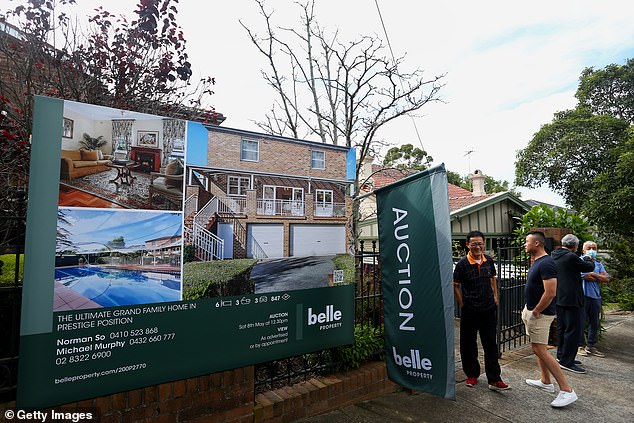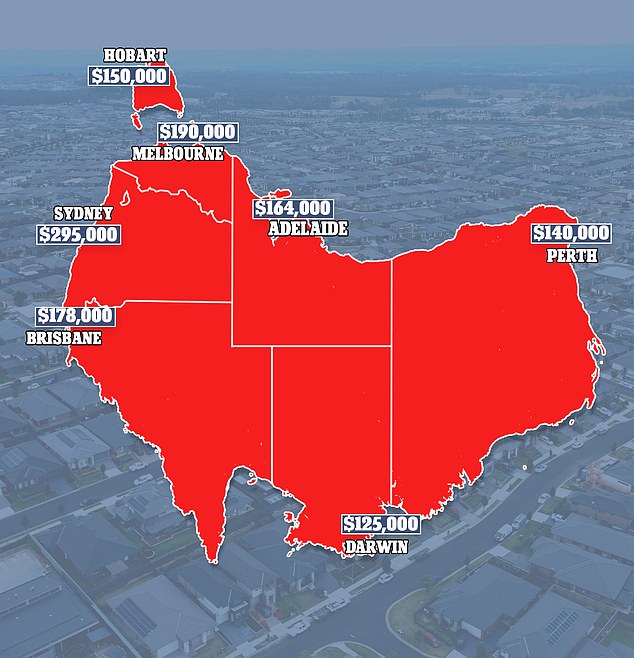Australia’s cheapest city is a long way from anywhere, inspiring an inverted map of the country that has divided opinion.
Darwin, Australia’s most affordable capital city, located in the tropical Top End region, still requires a six-figure salary to afford a mid-priced home without mortgage stress.
Sydney, Australia’s most expensive market, requires a prospective home buyer to have a salary of $295,000, which would put them in the top 1.5 percent of income earners.
Melbourne, Brisbane, Adelaide, Perth and Hobart are also areas that are out of reach for single-income earners looking to buy a home on their own, a situation that would have been unthinkable a generation ago.
Andrew Mitchell, founder of Ophir Asset Management, posted the upside-down map on LinkedIn to illustrate how buying a home is now unattainable for most single people.
“The great Australian dream of home ownership has been turned upside down,” he said.
Mr Mitchell, whose firm invests billions of dollars for pension funds, individual investors and family trusts, blamed local councils and negative gearing tax breaks for homeowner investors for Australia’s housing crisis.
“The dream of owning a home wasn’t always so far out of reach,” she said.
Australia’s cheapest city is so far from anywhere – it inspires an upside-down map
‘Decades of banking deregulation, investor-friendly taxes, structurally lower rates, more dual-income households and zoning restrictions have all helped push prices up.’
Another investment specialist, commenting on Mr. Mitchell’s post, said that unaffordable housing discourages innovation.
“What a waste of almost totally unproductive capital,” he said.
‘Land-based capital mostly employs no one, does not develop new products or services and does not contribute to the economy.
“It’s hard to imagine that owning such expensive properties doesn’t negatively impact people starting new businesses, investing in other businesses or productive assets, supporting start-ups and innovation. It really doesn’t bode well for the future.”
Another comment from a man who works in finance argued that telling young people it was too difficult would only discourage them.
“I think this is an argument for starting life young, not just perpetuating the idea that ‘it’s very difficult to buy a house’. It is difficult,” he said.
“In my experience, it’s always been difficult. It’s just that the reason it’s difficult changes.
‘Homeownership is the cornerstone of personal financial success in Australia.
“How about we all commit to helping younger generations figure out how to get into the real estate market, instead of psychologically harassing them with the constant mantra that it’s too difficult?”

Sydney is by far Australia’s most expensive market: someone needs to earn $295,000 (putting them in the top 1.5 per cent of earners) to be able to buy a median-priced $1.466 million home with a 20 per cent deposit and not suffer mortgage stress.
Sydney is by far Australia’s most expensive market: someone needs to earn $295,000 to be able to buy a median-priced $1.466 million home with a 20 per cent deposit and not be under mortgage stress.
This is when a borrower spends 30 percent or more of his or her salary on mortgage payments at a variable rate of 6.5 percent.
A homebuyer in this situation would also owe the bank less than four times his or her pre-tax earnings.
Baby boomers were able to do this in the 1980s, buying mid-priced homes in Sydney or Melbourne, but without having to earn an astronomically high salary.
At the bottom of the upside-down map, Darwin needs a salary of $125,000 (a salary 27 per cent higher than Australia’s average full-time wage of $98,218) to afford a $589,166 home.
In Melbourne, you need a salary of $190,000 to buy a house worth $948,879.
Brisbane required a salary of $178,000 at the start of 2024, but the median house price is now $953,028, meaning someone would need to earn $195,000 now.
In Adelaide, you need an income of $164,000 to buy a home priced at $824,669, compared with $150,000 in Hobart to buy a home priced at $691,339.
In Perth, a salary of $140,000 was once required to buy a typical home, but with the median house price now at $791,926, a salary of $162,000 would now be required.
House prices in Perth, Adelaide and Brisbane rose by double digits over the last financial year, despite Reserve Bank interest rates being at a 12-year high of 4.35 per cent.
A record 547,300 net migrants moved to Australia in 2023, the most ever for a calendar year, with new housing supply lagging behind population growth.

